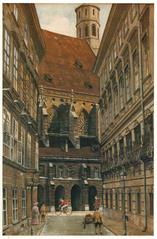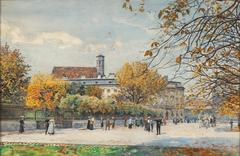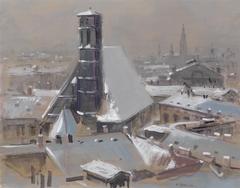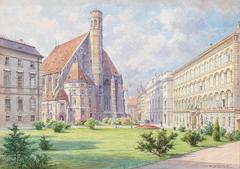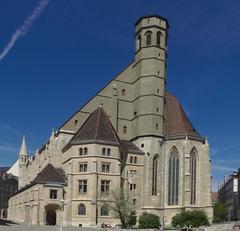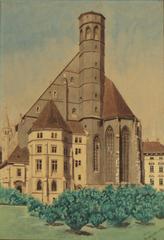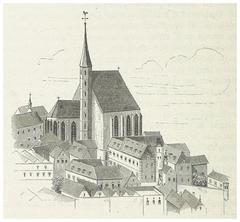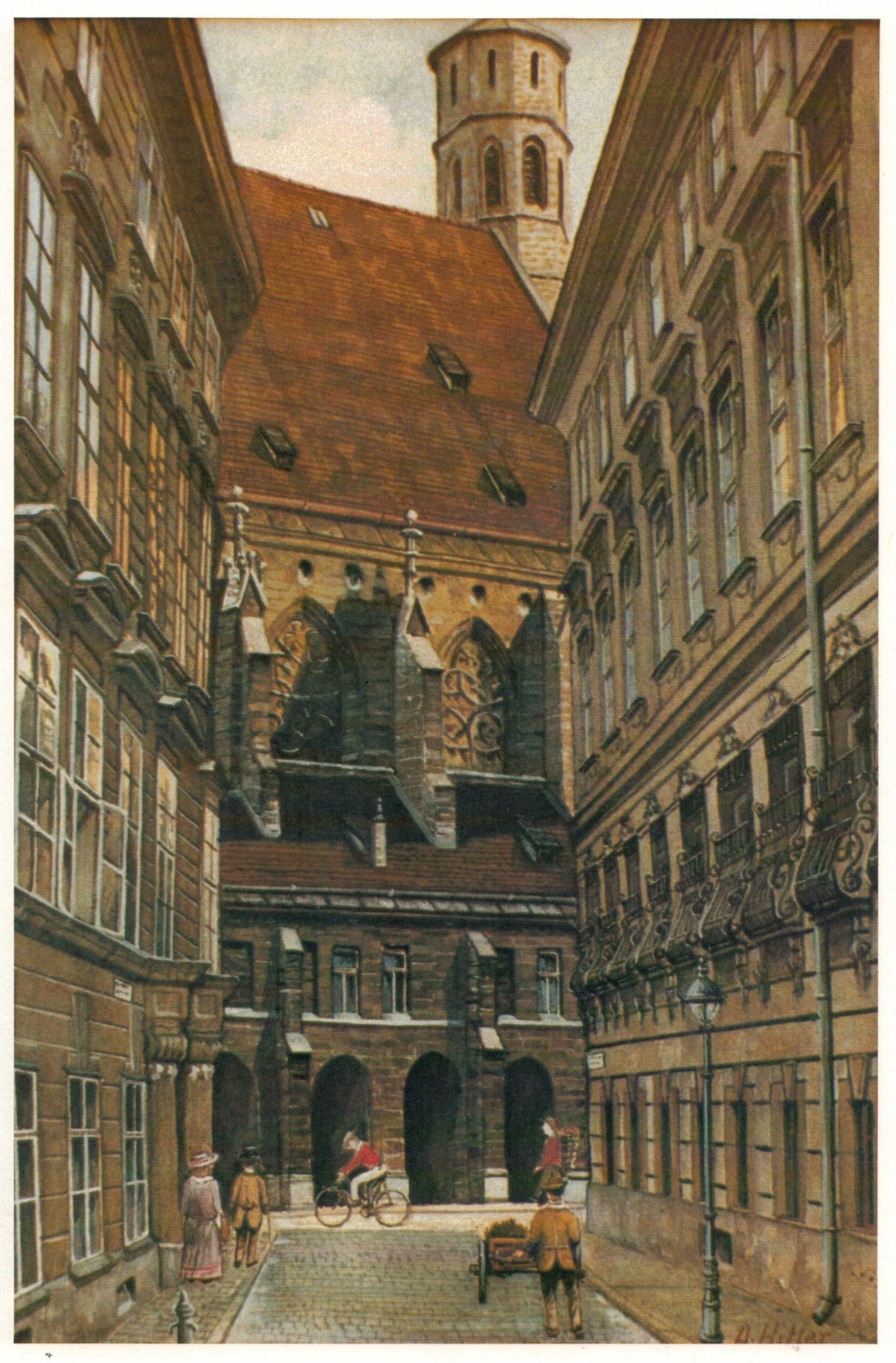
Minoritenkirche Vienna: Complete Visitor Guide, Hours, Tickets & Historical Highlights
Date: 14/06/2025
Introduction
The Minoritenkirche, also known as the Minorite Church or the Italian National Church of Mary of the Snows (Italienische Nationalkirche Maria Schnee), is a cornerstone of Vienna’s medieval and cultural heritage. Located in the city’s historic First District, this rare example of French Gothic architecture has stood since the early 13th century. Its history, artistic treasures—including the renowned mosaic replica of Leonardo da Vinci’s The Last Supper—and vibrant cultural presence make it an essential stop for visitors interested in architecture, music, and Vienna’s dynastic past (Vienna Itineraries, Tour My Country, Visiting Vienna, SpottingHistory).
This detailed guide covers Minoritenkirche’s visiting hours, ticketing, accessibility, travel tips, architectural highlights, and nearby attractions. Whether you’re a history enthusiast, art lover, or cultural explorer, you’ll find all the essential information for planning your visit.
Table of Contents
- Overview and Historical Background
- Architectural Highlights
- Artistic Treasures: The Last Supper Mosaic
- Visiting Hours, Admission, and Accessibility
- Travel Tips and Best Times to Visit
- Concerts and Special Events
- Nearby Attractions
- Preservation and Archaeology
- Frequently Asked Questions (FAQ)
- Conclusion and Recommendations
- References
Overview and Historical Background
Founded in 1224 by Franciscan monks and granted land by Duke Leopold VI, the Minoritenkirche is among Vienna’s oldest churches. Originally dedicated to St. Catherine, it was rebuilt in the late 13th and early 14th centuries in the French Gothic style under the patronage of King Ottokar II of Bohemia and later the Habsburgs. Its proximity to the Hofburg Imperial Palace established it as a spiritual and political center for Vienna’s elite (Tour My Country).
Through centuries of war, religious reforms, and dynastic changes, the church has witnessed Vienna’s evolution. Emperor Joseph II’s 1782 reforms transferred the church to Vienna’s Italian community, a role it maintains today through services, events, and cultural ties (Classictic).
Architectural Highlights
French Gothic Style in Vienna
Minoritenkirche is a rare example of French Gothic architecture in Austria, distinguished by its pointed arches, ribbed vaults, flying buttresses, and emphasis on vertical lines (Wikipedia). The main facade is understated yet elegant, with a pointed-arch portal and slender columns, while the interior features a spacious nave and high vaults that create an airy, uplifting atmosphere.
Octagonal Tower and Bell History
The octagonal tower, originally topped by a spire destroyed during the Turkish sieges, is a prominent city landmark. The tower’s bells have a storied history; most were requisitioned during World War I, but in 2024, 11 new bells were installed, restoring its chime (Visiting Vienna).
Ludwig Choir and Mausoleum
Constructed between 1316 and 1328, the Ludwig choir served as a mausoleum for Vienna’s nobility and remains one of the church’s most solemn and historically significant spaces (Wikipedia).
Portico and Stonework
A covered portico near the entrance displays historic stone relics and commemorative plaques, offering insight into the church’s layered past (RJ On Tour).
Artistic Treasures: The Last Supper Mosaic
The church’s greatest artistic highlight is the monumental mosaic reproduction of Leonardo da Vinci’s The Last Supper, crafted by Giacomo Raffaelli in the 19th century. Commissioned by Napoleon and later acquired by Emperor Franz I, this stunning mosaic measures nearly 9 meters wide and 4 meters high, making it one of the most significant copies of da Vinci’s original (365 Austria).
Other notable features include the Neo-Gothic altar, attributed to Ferdinand Hohenberg, and the richly decorated pulpit and side chapels, showcasing centuries of religious artistry.
Visiting Hours, Admission, and Accessibility
- Opening Hours:
- Monday to Saturday: 9:00 AM – 6:00 PM
- Sunday: 1:00 PM – 6:00 PM
- Hours may vary on public holidays and during special events. Check official sources for updates (Visiting Vienna, ViennaConcerts.com).
- Admission: Entry is free. Donations are welcome. Tickets are required for concerts and some special exhibitions (ViennaConcerts.com).
- Accessibility: The church is wheelchair accessible, with ramps at the main entrance and level flooring throughout most of the nave. For further accommodations, contact the church ahead of your visit.
- Guided Tours: Regular guided tours (including audio guides) are available in multiple languages. Booking in advance is suggested.
Travel Tips and Best Times to Visit
- Location: Minoritenplatz, Vienna’s Innere Stadt, near the Hofburg Palace and Vienna City Hall (Travelsewhere).
- Getting There: Accessible via U3 Herrengasse metro, tram, or bus. Walking is recommended within the historic center.
- Best Times: Weekday mornings or afternoons offer a tranquil experience. The church may be busier during Mass, religious holidays, or concerts.
- Dress Code: Modest attire is required; cover shoulders and knees, and remove hats.
- Facilities: No restrooms inside; public facilities are available nearby.
Concerts and Special Events
Minoritenkirche is renowned for its acoustics and regularly hosts classical music concerts, particularly during festival seasons and holidays. Performances often feature works by Bach, Mozart, Vivaldi, Schubert, and Tchaikovsky. Concert tickets can be booked online or at the venue, with seating categories to suit various budgets (ViennaConcerts.com, Vienna Unwrapped).
Nearby Attractions
- Hofburg Imperial Palace: Former seat of the Habsburgs, now museums and the Austrian National Library.
- Volksgarten: Historic public gardens.
- Burgtheater: Prestigious German-language theater.
- Vienna State Opera: World-renowned opera house.
- Spanish Riding School: Famous for its Lipizzaner horses.
- Albertina Museum: Home to one of the world’s largest graphic art collections (365 Austria, Away to the City).
Preservation and Archaeological Discoveries
The Minoritenkirche has undergone careful restoration to preserve its Gothic character. Archaeological finds during nearby subway construction revealed earlier chapel foundations, offering further insight into the site’s deep history (Tour My Country).
Frequently Asked Questions (FAQ)
What are Minoritenkirche’s opening hours?
Monday to Saturday: 9:00 AM – 6:00 PM; Sunday: 1:00 PM – 6:00 PM. Hours may change on holidays or event days.
Is there an entry fee?
General admission is free; donations are welcome. Concerts and exhibitions may require tickets.
Is the church wheelchair accessible?
Yes, the main entrance is accessible. Contact the church for specific needs.
Are guided tours available?
Yes, in multiple languages. Advance booking is recommended.
What is the best time to visit?
Weekday mornings or afternoons for a quieter atmosphere; evenings for concerts.
Can I take photos inside?
Photography is generally permitted, but please be respectful during services.
What nearby attractions can I combine with my visit?
Hofburg Palace, Volksgarten, Burgtheater, Vienna State Opera, and Albertina Museum.
Conclusion and Recommendations
Minoritenkirche is a hidden gem in Vienna’s historic core—a place where centuries of history, art, and music converge. Its French Gothic architecture, unique artistic treasures, and vibrant cultural calendar make it a rewarding destination for every visitor. Free entry and accessible facilities ensure it remains welcoming to all. Enhance your experience by attending a concert or joining a guided tour, and consider exploring nearby attractions for a comprehensive Vienna itinerary.
Before your visit, check official sources for updated hours and event schedules. For planning tools, event updates, and personalized travel tips, download the Audiala app and follow us on social media.
